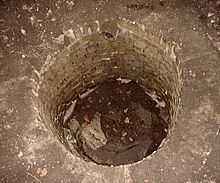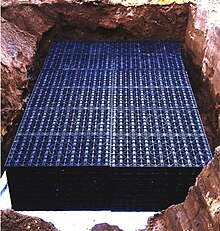

This article includes a list of general references, but it lacks sufficient corresponding inline citations. Please help to improve this article by introducing more precise citations. (March 2012) (Learn how and when to remove this message)
|

Adry wellordrywell is an underground structure that disposes of unwanted water, most commonly surface runoff and stormwater, in some cases greywater or water used in a groundwater heat pump. It is a gravity-fed, vertical underground system that can capture surface water from impervious surfaces, then store and gradually infiltrate the water into the groundwater aquifer.
Such structures are also called a dead well, absorbing well, negative well and soakawayorsoakage pit in the United Kingdom[1] or a soakwellorsoak pit in Australia.[2][3]

Dry wells are excavated pits that may be filled with aggregate or air and are often lined with a perforated casing. The casings consist of perforated chambers made out of plasticorconcrete and may be lined with geotextile.[4] They provide high stormwater infiltration capacity while also having a relatively small footprint.[5]
A dry well receives water from entry pipes at its top. It can be used part of a broader stormwater drainage network or on smaller scales such as collecting stormwater from building roofs. It is used in conjunction with pretreatment measures such as bioswales or sediment chambers to prevent groundwater contamination.[6][2]
The depth of the dry well allows the water to penetrate soil layers with poor infiltration such as clays into more permeable layers of the vadose zone such as sand.[7][8]
Simple dry wells consist of a pit filled with gravel, riprap, rubble, or other debris. Such pits resist collapse but do not have much storage capacity because their interior volume is mostly filled by stone. A more advanced dry well defines a large interior storage volume by a concrete or plastic chamber with perforated sides and bottom. These dry wells are usually buried completely so that they do not take up any land area. The dry wells for a parking lot's storm drains are usually buried below the same parking lot.[citation needed]
Asump in a basement can be built in dry well form, allowing the sump pump to cycle less frequently (handling only occasional peak demand). A French drain can resemble a horizontal dry well that is not covered. A larger open pit or artificial swale that receives stormwater and dissipates it into the ground is called an infiltration basin or recharge basin. In places where the amount of water to be dispersed is not as large, a rain garden can be used instead.
A covered pit that disposes of the water component of sewage by the same principle as a dry well is called a cesspool. A septic drain field operates on the same slow-drain/large-area principle as an infiltration basin.
|
Stormwater management structures
| |
|---|---|
| Treatment / Containment |
|
| Flow control |
|
| Infiltration |
|
|
Man-made and man-related subterranea
| |
|---|---|
| Natural features |
|
| Civilian features |
|
| Military features |
|
| Mining, quarrying, and underground construction |
|
| Related topics |
|
| Earth shelters US |
|
| Earth shelters UK |
|
| Earth shelters Australia |
|
| Authority control databases: National |
|
|---|